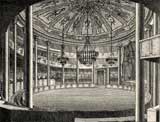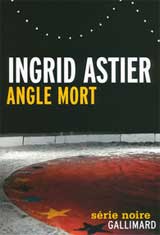Circus and popular novel
by Pascal Jacob
Undoubtedly offbeat, socially marginal, the circus has fascinated authors of popular literature since its origins or almost. With Les Mémoires de Grimaldi (Memoirs of Joseph Grimaldi) and Les Temps Difficiles (Hard Times for These Times), published respectively in 1853 for the former and in weekly serials in the Household Words magazine in 1854 for the latter, Charles Dickens (1812-1870) is a pioneering figure. Dickens finds in the clown's story some reminiscences of his own existence and he delivers a text that is both very affectionate for his main character and a precise and sometimes acerbic description of the times. The heroine of Temps difficiles (1880), a powerful social novel, illustrating the difficulties of adaptation of the business bourgeoisie and the working class to the new laws of an economy resulting from the industrial revolution, belongs to the world of the circus. Sissy Jupe is one of those strong characters, able to be resilient, very endearing and endowed with exceptional human qualities. To a certain extent, this expressive vein is also explored by Hector Malot with Sans Famille published in 1878 and also very rich in beautiful characters.
A world in motion
The advent and development of the big top (from 1825 in the United States) contributed to making the circus a popular form of entertainment from the end of the 19th century onward. Successfully embedded in most Western societies, it evokes the same envy for children everywhere, nostalgia and desire among adults. The circus, whether it is immense or tiny, is now part of the existence of millions of people. It fuels their imagination and awakens their minds. It is therefore not surprising that writers take hold of this marginal world and use it as a dramatic setting, context, effect or resource.
Circus stories are disruptive: they exacerbate unexpected outlines and upset established codes, describe a world where the unknown becomes a hero, where the anonymous knows glory and where a comfortable situation until then is suddenly compromised. The circus world is full of flamboyant characters and its history contains inexhaustible treasures in terms of extraordinary adventures, extraordinary situations and amusing, surprising or tragic anecdotes. In 1942, Guy des Cars set his Dame du Cirque in the shade of a gigantic tent that could well be the big top of the Gleich circus, a company for which the novelist worked as a press officer when this giant caravanserai was set up in Paris in the 1930s. It is easy to imagine the young author exploring the smallest corners of a unique camp and capturing scenes and memories. Many sequences of La Dame du Cirque are truthful thanks to him. Le Château du Clown, published in 1977, is inspired by the adventurous and exciting life, from anonymity to glory until the fall of the famous clown Adrien Wettach, better known as Grock. Here again, the attention to detail makes the whole thing, beyond the plot, rather convincing.
Adventures
The big top and its many vicissitudes inspired the authors throughout the 20th century, who made it a backdrop that was either shimmering or desperate. But above all, the circus sometimes becomes a real character, far beyond a simple setting, however richly described it may be. This is the case, for example, of Cirque Humberto by Eduard Bass, published in Czech in 1952 and quickly translated into many languages around the world. The novel vibrates with the same intensity as a show, with its highlights and moments of wonder, its moments of oblivion and its sequences of fear. The plot of Zingari by Paul Vialar, published in 1959, adapted into a comic strip by Yvan Delporte and René Follet in 1985, is inspired by the same sources, in a perhaps more expressionist tone, a novel that the painter Bernard Buffet could also probably have illustrated… Le jaguar noir by William Quindt, a thick novel published in 1957, embodies this popular trend influenced by exoticism, adventure and where the women and men who go through them are able to transcend their weaknesses to escape their initial condition. Motivated by the first sentence of the poem Saltimbanques by Guillaume Apollinaire, the translation of Love, let me ot hunger by Paul Gallico (1897-1976) was published in French in 1973, ten years after its original publication. The novel alternates between a desperate fresco and an initiatory journey, with the right dose of tragedy and humour to make it a rather successful and little-known novel "about the circus".
A young man hates lions. In itself, the anecdote is of little interest, unless the boy comes from a family of trainers and only dreams of going on a trapeze! Meeting a famous trapeze artist would change his life, but their complicity gradually turned into love and displaying such an affair in the 1940s was not easy. The Catch Trap, a novel by Marion Zimmer Bradley published in 1979, has been acclaimed by the press and the public and has established itself as a strong, well-reasoned and sensitive book in a highly contrasting world.
The theme of the circus, notoriously its shadowy side, is regularly questioned by the American novelist John Irving. He made it a key element of Un enfant de la balle, in 1998, a context that he used again in a more distant way in 2002 in La Quatrième Main, and again in 2016 in Avenue des mystères, a novel in which the Cirque de la Maravilla functions both as a possibility of self-acceptance for one of the characters and as a powerful activator of the imagination for others, including the reader fascinated by the daily life of a Mexican troupe, as destitute and as fanciful as the Indian circuses in its two above-mentioned works could have been.
Contextualisation is sometimes decisive, especially when the author chooses to refer to a more or less distant past. With De l’eau pour les éléphants, Sara Gruen opened the sinister Great Depression Ball in 2007 and confronted her characters with the harshness of the 1930s. The staging works well and even if the purist gets a little annoyed sometimes, most references ring true with the necessary accuracy to transport the reader to the heart of a dense and hard story. The same year, the British novelist Tracy Chevalier chose to go back in time to give L’Innocence a historical and pictorial dimension. By mixing the figures of Philip Astley, credited with being the father of the modern circus, and William Blake (1757-1827), painter and engraver, with graphic visions of extraordinary power, she wove the threads of an initiation adventure where the circus seemed to take more space than expected, sometimes creating an imbalanced text where references to the circus arts are often clumsy. We find this same dangerous fascination for a theme that can be overlooked due to too much respect in Bravoure by Danielle Steel, published in 2016. The novel sweeps away European and American history at the time of the Second World War and gives a certain naivety to the epic dimension of the circus, often far removed from reality.
Intrigues

The detective novel provides an interesting contingent of works in which the circus is revealed as a setting, a pretext or a character in its own right. Sir Arthur Conan Doyle (1859-1930) did not neglect this singular universe, woven with references for the location of several of his works. The Adventure of the Veiled Lodger, published in 1927 in the weekly Liberty, The Dark Tragedy of the Circus, a radio novel broadcast in 1942 and The Mystery at Mandrake’s Circus, a story on the edge of the worlds of magic and circus. The inspiration is clearly drawn from the aesthetics of a circus that is more Victorian than modern, but the dark corners of the big top and the shadows cast by the trailers and caravans provide a beautiful backdrop against which to create situations and characters. Val Andrews (1926-2006) revives the character created by Doyle for Sherlock Holmes and the Circus of Fear, an adventure that he sets in the context of the Sanger circus with a photo of the tamer Jack Bonavita with his lions to illustrate its cover.
Enquête à Médrano was published in 1952 by Éditions Hachette by Marcel Pierre, a pen name composed from the first names of the two partner clowns, Pedro, Marcel Chausse, and Punch, Pierre Bonvallet. They rely on a place they know well to locate a classic police plot there and give it a real behind-the-scenes feel. The authors performed on this Parisian ring as a duo for clown entrées from the traditional repertoire, a way for them to add a particular flavour to the description of a universe that was very unknown at the time of publication.
Georges C. Chesbro (1940-2008) created in 1977 a recurring and singular character, Dr. Robert Fredrickson known as Mongo le Magnifique, a dwarf criminologist whose qualities as a former acrobat are very useful in regularly getting out of difficult situations. Hero of 14 novels, including Le Chapiteau de la peur aux dents longues, Mongo belongs to the travellers' world from which he has escaped to return to it more successfully, using his multiple talents to triumph from one book to the next. The young Swedish novelist Camilla Läckberg has set one of her intrigues on the fringes of the circus world, taking advantage of the usual setting where her heroes live their adventures to weave a story with ancient ramifications, initiated at the time when a travelling circus stopped in Fjallbacka, a charming village where police-related issues are a regular part of life.
Le Dompteur de lions, published in 2016, uses the circus as a simple pretext, a fictional starting point, even if the title of the book is unequivocal... With Angle mort published in 2013, the novelist Ingrid Astier crosses a new threshold in the integration of a universe from which she chooses to isolate the asperities and the shadowy aspect. She details its stanzas with entomological precision until it becomes a tragic and romantic context. The circus is not only a pretext, but also a metaphor for all the dangers to which the various protagonists of the work are exposed. Very dark, this detective novel celebrates the troubled union of two worlds with very strict codes, but which finally resonate with great accuracy.
The very diverse range of literary productions in which the circus plays a more or less important role attests to this symbolic attachment to a universe that is both familiar and unknown: from Charles Dickens to Camilla Läckberg, the writing and reading prism is ultimately as accurate as it is ambiguous, a succession of situations and stories that clearly demonstrate how much the circus is a theme... that is in fact infinite.






